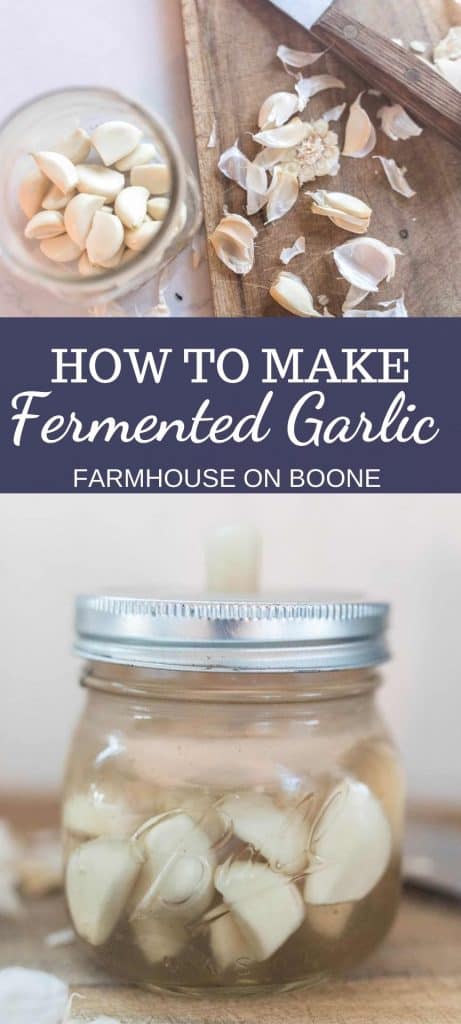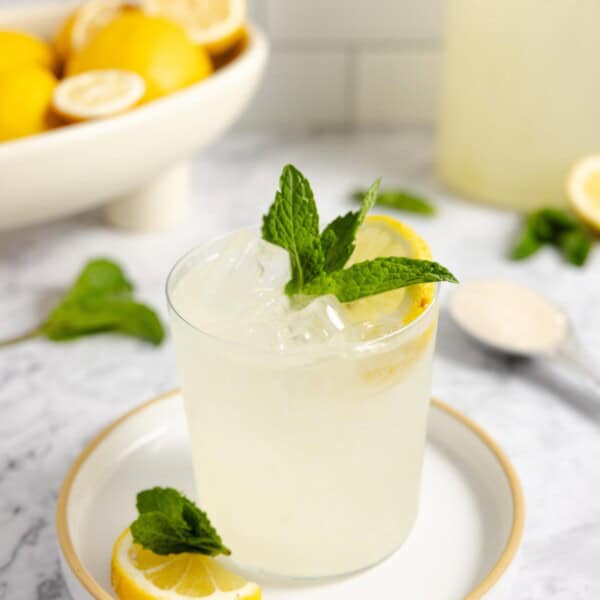Learn how to make lacto fermented garlic that is an easy and delicious way to add probiotics to your diet. Follow me as I take you step-by-step to make this delicious and easy recipe.
My love for garlic runs deep. You will frequently see me adding a whole head of roasted garlic to soup, or pan frying it with some pork chops.
Here’s the thing: fermented foods are also a passion of mine. See where I’m going with this?
Fermented garlic almost tastes like the combination of raw garlic and roasted garlic. Fermenting mellows out the strong flavors and makes it oh-so-delicious.
No meal is complete in our house without some type of fermented food (like some pickles, sauerkraut, or salsa), and adding this garlic recipe makes it that much easier.
You can use fermented garlic as you would pickled garlic: in soups, salads, stir frys, salad dressings, dips, marinades, and more. The possibilities are endless.
It is a great way to sneak in some healthy probiotics into a recipe you would normally use garlic in anyhow. Just be careful to not heat it up too much, killing the good bacteria.
Is fermented garlic good for you?
Yes. Regular garlic is a nutrient-dense food, with B vitamins, antioxidants, vitamin C, selenium, manganese, and more. It has also been shown to have natural antiviral and antibacterial properties.
During the fermentation process, the good bacteria (lactobacillus) that is already present on the garlic grows with a little time, while the salt from the brine inhibits the bad bacteria.
This process allows the nutrients already naturally present in garlic to become more bio-available to you during digestion, and also has the added benefit of probiotics.
Probiotics can aid in gut health, which has been shown to help your immune system, decrease inflammation, and can help decrease the incidence of certain diseases, like heart disease. (source).
How long does fermented garlic last?
It will last up to a year in the refrigerator.
Always look for any signs of mold, and be sure that there is an even color throughout and it still looks edible. It is normal for fermented garlic to change color.
Smell it to make sure it still smells right, and doesn’t have an off or bad smell. Check to make sure the texture is still good, and not mushy. You can always taste it to make sure it tastes good.
Tips For Making Lacto-Fermented Garlic
- After the garlic has been fermenting for about 3 weeks, give it a taste to see if it’s where you like it. If not, then leave it for another week or two.
- Add dried herbs, like basil, thyme, oregano, or parsley to the brine to add some delicious flavors.
- Use fermented garlic in any recipe that calls for raw garlic. Avoid heating it because it will kill the good bacteria.
This post contains affiliate links, which means I make a small commission at no extra cost to you. See my full disclosure here.
Tools you may need:
Liquid measuring cup
Glass fermenting weight (optional as garlic doesn’t tend to float, and stays under the brine well.)
Ingredients:
- Peeled garlic: Usually I peel garlic by cutting off the top and then peeling each clove with my hands.
- You can also pull the cloves from the head and place them in a mason jar with a tight lid. Shake for about 20-30 seconds and the peels will just comes off.
- Water: choose non-chlorinated water. I use water from my Berkey water filter
- Salt
- Herbs (optional)
How To Make Lacto-Fermented Garlic
- Create brine by warming up water and dissolving salt. Set aside to cool.
- Peel garlic and fill a quart-sized mason jar, leaving about 1 inch of head space.
- Add any dried herbs, like basil, oregano, or thyme, if you would like.
- Pour cooled brine over peeled garlic, leaving 1 inch head space, and place fermentation lid on top. You can place a glass weight on top of the garlic to make sure it stays below the brine, but typically, garlic doesn’t float up above the brine.
- Allow to ferment for 3-4 weeks (or longer), then refrigerate or place in a cool root cellar.
Find More Delicious Recipes Straight From The Farmhouse Kitchen
- Sourdough Crepes Recipes
- How To Make Raw Milk Yogurt In The Instant Pot
- Homemade Apple Pie Recipe With Einkorn Crust
- Best Deviled Eggs Recipe
- Breakfast Pizza Recipe With Sourdough Crust
Lacto-Fermented Garlic

Ingredients
- 3-4 heads peeled garlic
- 1 quart Water - filtered
- 2 1/2 tablespoons salt
- Herbs, optional
Instructions
- Create brine by warming up water and dissolving salt. Set aside to cool.
- Peel garlic and fill a quart-sized mason jar, leaving about 1 inch of head space.
- Add any dried herbs, like basil, oregano, or thyme, if you would like.
- Pour cooled brine over peeled garlic, leaving 1 inch head space, and place fermentation lid on top.
- Allow to ferment for 3-4 weeks (or longer), then refrigerate or place in a cool root cellar.
Notes
- Allow the garlic to ferment about 3 weeks and then give it a taste to see if it tastes how you like it. If not, then leave it for another week or two.
- Add dried herbs, like basil, thyme, oregano, or parsley to the brine to give it some extra delicious flavor.
- Use fermented garlic in any recipe that calls for raw garlic. Avoid heating it because it will kill the good bacteria.
Nutrition
Nutrition information is automatically calculated, so should only be used as an approximation.














I just started a jar of this yesterday and it smells strong but good. I’ve done a fair amount of fermenting and usually go with a 2 percent brine solution by weight in the colder months and 2.5 to 3 in the summer. The weight of salt can differ by almost 100 percent depending on the brand!
Is it normal that some of my garlic cloves are getting a green tint? I’m deathly allergic to mold so it’s slightly creeping me out. It doesn’t smell bad it just smells “weird” but this is my ferment
Yes, this is normal for it to start to have a blue green tint to it.
I guess she isn’t answering questions about the salt:water ratio, so I’ll give it a shot, and she can correct me if she’d like. My suggestion is to use between a tablespoon and four teaspoons per pint of water. I usually mix a quart at a time, so I use 2 to 3 Tbsp per quart (I realize this is a bigger range). Hope this helps! Eat lots of garlic!!!
My garlic molded…I guessed on the salt measurement as you left it out in your recipe. Could I suggest you edit your most wonderful recipe blog, so others do not waste their garlic? Thanks 😊
Hi Lisa, how much salt is enough? How little is okay? There’s no information in the recipe.
Thanks!
I have a lovely jar or garlic going and it’s been somewhere between 2-3 weeks. This is my first time though, and although I expected some color change, I didn’t expect my results lol. Some of the cloves in the jar are still a normal whitish color, and others are a sort of golden tan color (all the way through). Both colors taste the same and have the same semi crunchy texture (neither are mushy at all). My instincts tell me this is OK hopefully, and I’ve read other sources about fermenting garlic paste where it turns golden (apparently the sugars caramelize from the fermenting even though there’s no heat?). Since it’s my first time though, I figured I’d double check and share to see if anyone else has experienced this? I too am a garlic lover and have been super interested and slowly delving into the fermenting world 😊
Ingredients
A few heads of peeled garlic
1 quart Water – filtered
2.5 tbs Salt
Herbs (optional)
I copied this from her page, she gave the measurement.
I have a jar that’s about a week old on my counter right now. O. M. G. The smell. My whole kitchen smells like garlic. Any ideas on when that will ease up?
All ferments are pretty stinky, but garlic exceptionally so!
What salt to water ratio do you use?
I absolutely love fermenting foods! Can’t wait for this!
I am in love with garlic, as well! This is awesome!